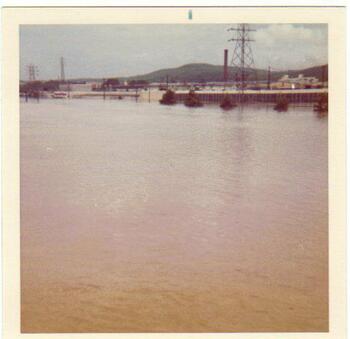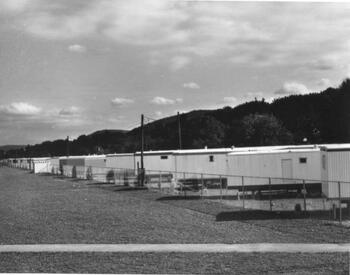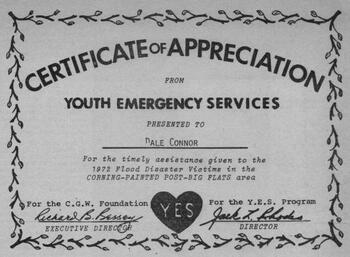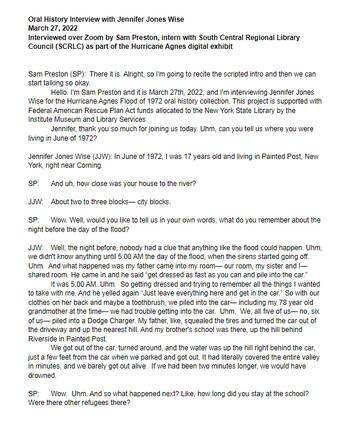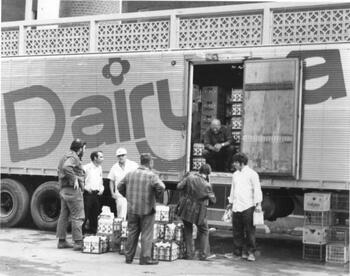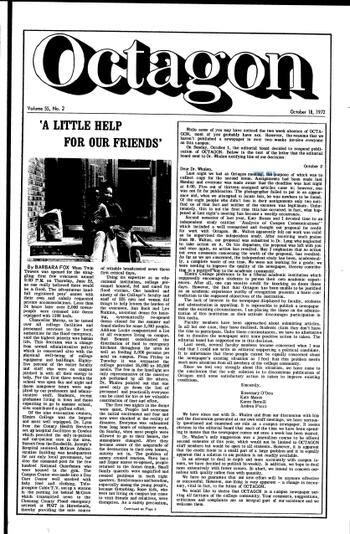Numerous organizations donated supplies and labor to assist in the recovery efforts. Teenagers from Auburn traveled by bus to Corning to help in the cleanup. Multiple church groups from all over New York sent volunteers. Businesses from the region sent support, such as the Eastman Kodak company, which enlisted volunteers from Rochester.
The Genesee Beer Company used their bottling facilities to send clean water to affected regions. Many residents of Corning and other flooded communities recall seeing people drinking water out of beer bottles.
Local employers like the Ingersoll-Rand plant in Painted Post, which employed more than 2,200 people, had to rapidly reorganize their workers to restore facilities and get back to work. The company and the electrical workers union came to an agreement that all workers could be paid a flat rate for cleanup efforts at the plant. Ingersoll-Rand, like many other local companies, showed flexibility for employees to take "vacation" time, doing necessary flood recovery work personally and for the community.
Ingersoll-Rand across the 4-lane. Courtesy of Lois Crandell over Facebook.
Ingersoll-Rand had a century of history around Painted Post. They allowed their employees to head home early on Thursday afternoon as flood warnings grew more serious.
Joseph J. Kane, who later became the Historian for the Town of Erwin and the curator for the Town of Erwin Museum, spent forty years working for Ingersoll-Rand in Painted Post. He shared his memories of the flood with The Crooked Lake Review in 1992, noting:
"In closing, it is quite proper to say that the people of Painted Post, the Village officials, Ingersoll-Rand officials, and many auditors were really wonderful to work with. Everyone showed a real concern for the difficulties that we all had to some extent. Even the contractors helped by removing most of the houses at night so the owners would not see them being taken down. All in all, we were a people who struggled through a difficult time relying on our courage, strength, and good humor, as well as the support of each other to make it through the hardships. The people of Painted Post shared their troubles and their sadness and pulled together to reclaim their Village."
Emergency housing trailers at Craig Park on Victory Blvd in Painted Post. Courtesy of the Corning-Painted Post Historical Society and Steuben County Historical Society.
The donated trailers from the U.S. Department of Housing and Urban Development (HUD) formed an improvised settlement for local residents who had lost everything. Over 19,000 houses were destroyed in the most affected counties. Residents lived in the trailers for years as their houses were rebuilt.
Certificate of Appreciation presented to Dale Connor by Youth Emergency Services. Courtesy of Corning-Painted Post Historical Society and Steuben County Historical Society.
Corning Glass Works hired hundreds of teenagers as the Youth Emergency Services (YES) and paid them to do cleanup work around the city. The most positive takeaway from the stories from Agnes’s survivors describe people coming together to help each other.
Flood of 1972 Interview with Jennifer Jones Wise. Courtesy of the South Central Regional Library Council.
Jennifer Jones Wise describes the flood of 1972 in Painted Post and how it affected her and her family. She participated in the Youth Emergency Services (YES) program to help clean up. She recalls traveling around in the back of a pickup truck that summer, with other teens, one of whom became a lifelong friend.
Men unloading crates of milk from a Dairyland truck at the Corning Hospital. Courtesy of the Corning-Painted Post Historical Society and Steuben County Historical Society.
Emergency supplies were sent from all over the region to the affected areas. The hospital in Corning became a relief center for food and water for local residents.
Here, supplies can be seen being unloaded in the hospital’s parking lot.
"A little help for our friends. The Octogon (Elmira College). October 18, 1972. Courtesy of Elmira College.
Elmira College's student newspaper described how the dormitories were used for evacuees during the June flooding:
"When Twin Towers was opened for the straggling first few evacuees around 9:00 PM on Thursday, June 22, no one really believed there would be a flood. The adventurous handful registered pets' names with their own and calmly requested private accommodations. Less than 24 hours later over 2,000 townspeople were crammed into dorms equipped with 1200 beds."
Elmira College provided all manner of emergency support for weeks by housing, feeding, and caring for the flood victims with college facilities and personnel. By the fall, the college estimated that the costs associated with housing evacuees were around $250,000, which was unrelated to any flood damages.
Evacuees went home or to emergency trailers in August. Into October of 1972, Elmira College was still hosting the Elmira Day Care Center, the Mennonite Disaster Volunteers, and the Neighborhood Youth Corp.
StoryCorps Oral History Interview with Georgia Verdier. Courtesy of the Southeast Steuben County Library.
Georgia Verdier shares that the flood taught her to appreciate how strong she is and how nice it was to see the community come together in a crisis. Her neighbors, whose house was just a block away up the hill, were unaffected by the flooding, and they happily opened their doors to Georgia's family.
